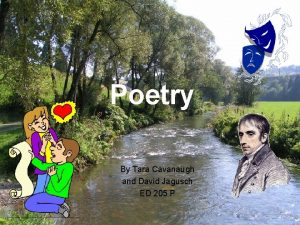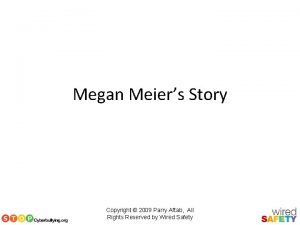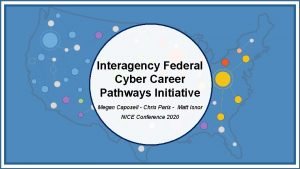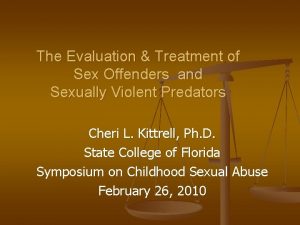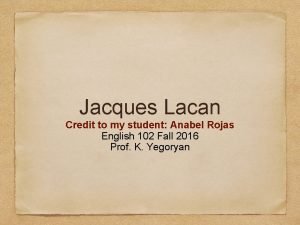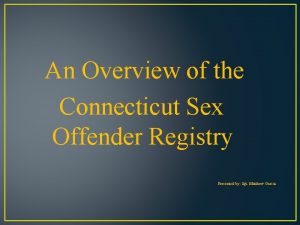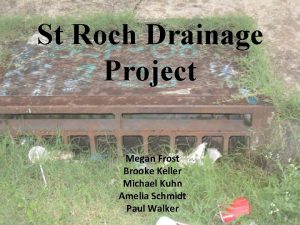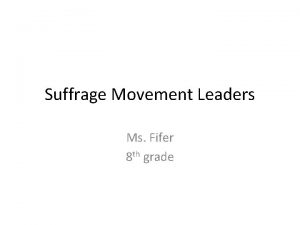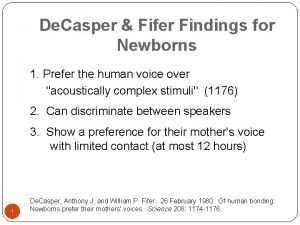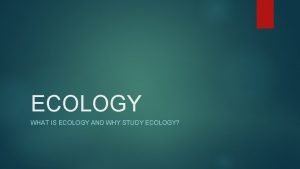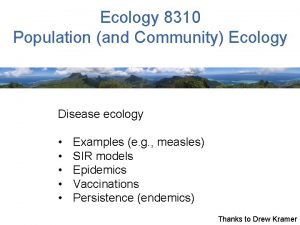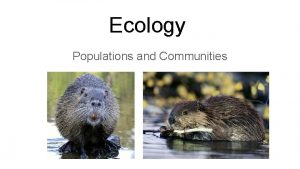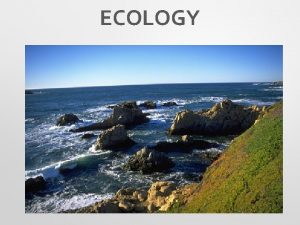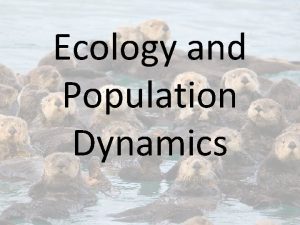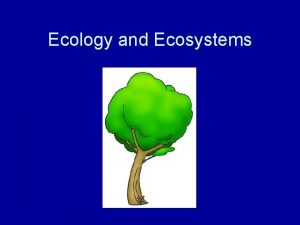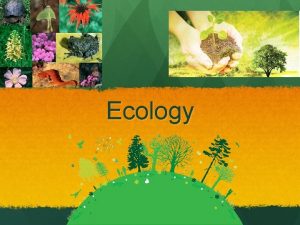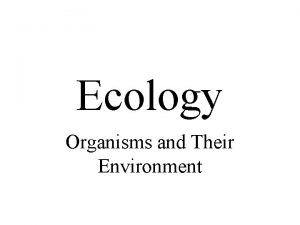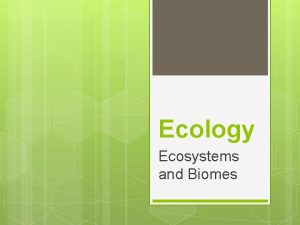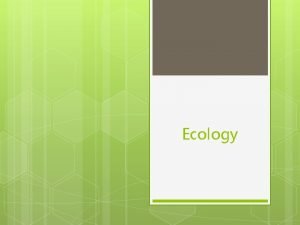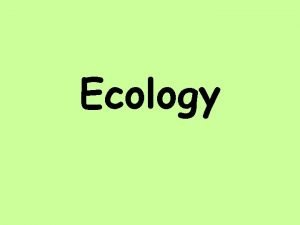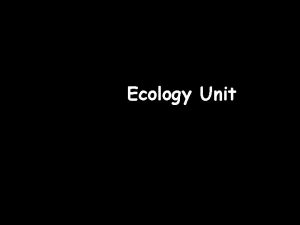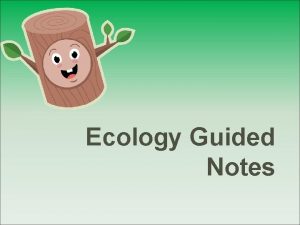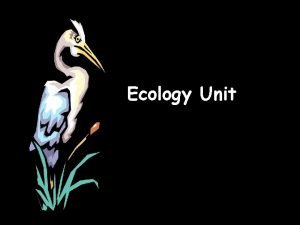ECOLOGY AND EVOLUTION Megan Fifer Justin Cavanaugh Sam


























- Slides: 26

ECOLOGY AND EVOLUTION Megan Fifer Justin Cavanaugh Sam Denison Madison Oliver Katelyn Cox

CHARLES DARWIN Studied finches and tortoises Darwin’s theory of natural selection states that inheritable variations occur in individuals in a population. Artificial selection- the process by which a breeder chooses the traits they want An adaptation is a genetic variation that is favored by selection and is manifested as a trait that provides an advantage to an organism in a particular environment. Hardy-Weinberg can be used to calculate changes in frequencies.




https: //www. youtube. com/ watch? v=o. EBNom 3 K 9 c. Q






EVIDENCE OF EVOLUTION Fossils are the remains and traces of past life Transitional fossils- a common ancestor of two different groups of organisms Biochemical evidence- similarity in DNA sequences and proteins in cellular respiration Analogous structures- same function but constructed differently Homologous structures- inherited from common ancestor Vestigial organs- anatomical features that are fully developed but are reduced and may no longer have a function Developmental similarities Example: Pax 6 gene is involved in eye formation in all animals

ORIGIN OF LIFE ON EARTH Primitive Earth provided inorganic precursors from which organic molecules could have been synthesized due to the presence of available free energy and the absence of a significant quantity of oxygen. Building blocks for more complex molecules (amino acids and nucleotides) The RNA World hypothesis proposes that RNA could have been the earliest genetic material. Chemical experiments have shown that it is possible to form complex organic molecules from inorganic molecules in the absence of life. Molecular and genetic evidence from extant and extinct organisms indicates that all organisms on Earth share a common ancestral origin of life.

ECOLOGY INTRODUCTION Video song

COMMUNICATION Fight or flight response • Bee dances Predator warnings • Birds songs Protection of young • Territorial marking in mammals Plant-plant interactions due to herbivory • Pack behavior in animals Avoidance responses Herbivory responses • Herd, flock, and schooling behavior in animals Territorial marking in mammals • Predator warning Coloration in flowers • Colony and swarming behavior in insects • Coloration

RESPONSES TO COMMUNICATION Cooperative behavior tends to increase the fitness of the individual and the survival of the population. Parent and offspring interactions Migration patterns Courtship and mating behaviors Foraging in bees and other animals Avoidance behavior to electric fences, poisons, or traps Pack behavior in animals Herd, flock and schooling behavior in animals Predator warning Colony and swarming behavior in insects

LEARNING FOR ORGANISMS Instinct Imprinting- any kind of phase-sensitive learning that is rapid and apparently independent of the consequences of behavior. Social interactions Associative learning- association made between two events Classical conditioning- paired presentation of two different types of stimuli Operant conditioning- stimulus response connection is strengthened Insight learning- an animal suddenly solves a problem

BEHAVIOR ECOLOGY Animals become territorial because they have found a good food source or a good area to reproduce. Optimal foraging model- it is adaptive foraging behavior to be as energetically efficient as possible.

SYMBIOTIC RELATIONSHIPS Parasitism-parasite gains and host looses Commensalism- one species gains and the other is not affected Mutualism- both species gain

SPECIATION Speciation results in diversity of life forms. Species can be physically separated by a geographic barrier such as an ocean or a mountain range, or various mechanisms can maintain reproductive isolation and prevent gene flow. New species arise from reproductive isolation over time, which can involve scales of hundreds of thousands or even millions of years, or speciation can occur rapidly Isolation: Allopatric- geographic separation Sympatric- still live in the same area

PRE-REPRODUCTIVE BARRIERS

POST REPRODUCTIVE BARRIERS

CYCLES

CYCLES

CYCLES

ESSAYS! AP 2004 AP 2011 answers More essays
 Mary beth yokomi
Mary beth yokomi Dr timothy cavanaugh
Dr timothy cavanaugh Scac retl
Scac retl Monorhyme examples
Monorhyme examples 5 evolution and community ecology
5 evolution and community ecology Chapter 5 evolution and community ecology
Chapter 5 evolution and community ecology Chapter 5 evolution and community ecology
Chapter 5 evolution and community ecology Megan and ron ate too much and felt sick
Megan and ron ate too much and felt sick Unmc obgyn residents
Unmc obgyn residents Megan meiers
Megan meiers Dr angelo costas
Dr angelo costas Fortran c interoperability
Fortran c interoperability Cyber career pathways tool
Cyber career pathways tool Chester anuszak
Chester anuszak Megan andring
Megan andring Megan kanka
Megan kanka Megan madrigal md
Megan madrigal md Megan templin
Megan templin Megan jacques
Megan jacques Megan suelzer
Megan suelzer Megan koeth
Megan koeth Danielle coutts
Danielle coutts Megan e
Megan e Soil mix
Soil mix Megan kanka
Megan kanka Megan roch
Megan roch Megan cheever
Megan cheever



